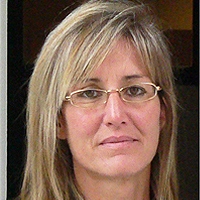Chlorophylls and xanthophylls of crop plants as dyes for Dye-Sensitized Solar Cells (DSSC)
Published on: 11th October, 2017
OCLC Number/Unique Identifier: 7286354251
Natural dyes have become a viable alternative to expensive and rare organic sensitizers because of their low cost, easy attainability, abundance of supply of raw materials and environmental friendliness. Chlorophyll, the most abundant pigment, can be extracted from plant leaves with simple and inexpensive methods, but it’s difficult to use as a Dye-Sensitized Solar Cells (DSSC) sensitizer due to the absence of OH and COOH groups. The opposite is true for xanthophylls, a particular class of carotenoids that contain free hydroxyl groups and thus may be considered as potential DSSC sensitizers. In this work we describe a new and inexpensive method of chlorophyll extraction from leaves based on the use of a basic solvent that provides the creation of COOH groups, allowing chlorophyll binding on the TiO2 layer. This modified chlorophyll dye showed a higher DSSC efficiency level (0.72%) compared to xanthophylls, which had lower efficiency.
The Efficacy of Quercetin in Attenuating Oxidative Stress and Clinical Symptoms in Allergic Rhinitis: A Systematic Review
Published on: 26th August, 2025
Background: Allergic rhinitis (AR) affects approximately 10% - 30% of the global population and represents a significant healthcare burden. The condition involves complex inflammatory pathways where oxidative stress plays a crucial role, with malondialdehyde serving as a key biomarker of cellular damage. Quercetin, a naturally occurring flavonoid, demonstrates promising antioxidant and anti-inflammatory properties that may benefit allergic rhinitis management.Methods: We conducted a systematic review following PRISMA 2020 guidelines. Four electronic databases (PubMed, Google Scholar, SagePub, and Semantic Scholar) were searched for studies published between 2000 and 2024. The PICO framework guided study selection, focusing on quercetin intervention in allergic rhinitis models. Both preclinical and clinical studies measuring malondialdehyde levels or clinical symptom improvement were included.Results: Eighteen studies met our inclusion criteria, comprising 14 animal studies and four human clinical trials. Preclinical evidence consistently demonstrated quercetin’s ability to reduce malondialdehyde levels across various tissues, including serum, lung, and liver samples. Human studies showed superior symptom improvement when quercetin-containing supplements were added to standard therapy compared to conventional treatment alone.The primary mechanism involves nuclear factor erythroid 2-related factor 2 pathway activation, enhancing endogenous antioxidant enzyme production.Conclusion: Current evidence supports quercetin’s effectiveness in reducing oxidative stress and improving clinical outcomes in allergic rhinitis through dual antioxidant and anti-inflammatory mechanisms. While most evidence derives from animal studies, quercetin Shows promise as safe adjuvant therapy. Large-scale human clinical trials using high- high-bioavailability formulations are needed to establish standardized clinical protocols.Key messages:• Quercetin consistently reduces oxidative stress markers in allergic rhinitis models.• Clinical symptoms improve significantly when quercetin supplements are added to standard therapy.• The therapeutic mechanism involves both direct antioxidant activity and endogenous defense system enhancement.• High-quality human clinical trials are needed to establish definitive treatment guidelines.
Common transcriptional regulation of ABA and ethylene
Published on: 3rd January, 2018
OCLC Number/Unique Identifier: 7347046733
Plant hormones are versatile chemical regulators of plant growth. The concept of hormone ‘interaction’ [1] has gained much importance and several key players of hormonal network are uncovered for major plant hormones. The fact that hormones are structurally unrelated and their interaction elicits different genomic and non-genomic responses suggest hormone interaction involve co-regulation at multiple levels [2]. Recent studies suggest that hormonal interaction involves control over biosynthesis genes [3-6], key components of signalling pathways [7,8], hormone distribution [9,10], and interaction at the level of gene expression [11-13].
Pharmacological effects of Nephrolepis exaltata L. (fern) aqueous extract on an insect-based model (Nauphoeta cinerea)
Published on: 27th March, 2018
OCLC Number/Unique Identifier: 7794362580
In this work we used semi-isolated heart of the cockroach Nauphoeta cinerea for the investigation of the pharmacological effects of extracts (aqueous, 1:1, 1:2, 1:4 and 1:8) from Nephrolepis exaltata L. leaves, a popular ornamental fern considered to be safe. The use of insects in experimental studies has grown due to the easy handling, proliferation/growing assuring its rapid obtention, and absence of ethical issues. An aqueous extract 0.2 % was obtained after maceration of 1 g N. exaltata leaves powder with 20 mL of distilled water (1:20). Diluted extracts in water were obtained to have the following proportion 1:1, 1:2, 1:4 and 1:8. Experiments (n=4) consisted of 200 µL addition onto semi-isolated heart preparation of N. cinerea with concomitant heart beating counting. Aqueous, 1:1 and 1:2 extracts paralyzed completely the heart beatings of cockroachs (p<0.05 compared to saline control), but not 1:4 or 1:8, which showed only a slight decline (p>0.05 compared to saline control). A preliminary thin layer chromatography showed the presence of unidentified terpenoid in aqueous extract of N. exaltata. These pharmacological findings of N. exaltata can be exploited for future use as insecticide or as dose-dependently cholinergic agent.
Novel Mutation in Famous Gene Diseases in Red Blood Cells
Published on: 9th September, 2025
One of the most important and critical red blood cell disorders is dysfunction and deformation of the membrane structure, which affects the metabolic and biological red blood cell functions. On the other hand, the basic causes of these problems are the genetic mutations in the production of proteins that correlate to the structure and receptors of cells. The diagnosis methods and techniques are the other essential points that focus most scientists on. In this systematic review, the article pointed to the key title, which is the diagnosis of novel genes with different techniques and methods. The result of articles studies that were published in the last decades underlined the types of techniques such as Whole-Exome Sequencing, Quantitative Real-Time PCR, Targeted Next-Generation Sequencing, and Sulphate-Polyacrylamide Gel, which investigated the different membraned gene mutations that are novel and correlated to the genes that make the structures and functions of red blood cells such as hereditary spherocytosis, hereditary elliptocytosis, hereditary pyro poikilocytosis. In addition, the hereditary membrane disorders correlated to others, such as hereditary spherocytosis, have a relationship with vitamin B12, immunodeficiency.
Asynchronous flowering in clonal seed orchards - An effective strategy for alternative management
Published on: 15th May, 2019
OCLC Number/Unique Identifier: 8165493426
Tropical forests have long been of interest to biologists because of their high species diversity and their complicated patterns of community organization. The recent ecological studies which have demonstrated that tropical trees are diverse in their reproductive biology and dynamic population structure. Asynchronous flowering among the clones in a clonal seed orchard is an inherent problem resulting in poor seed and fruit set in them. These results in the complete defeat of the prime objective of establishment of clonal seed orchards (CSOs) i.e. abundant quality seed production poor flowering and asynchronous flowering between the clones are a major bottleneck in higher seed set in these clonal seed orchards across the country. Asynchrony found between clones may be attributed to the origin of clones, which are collected from different zonal populations as revealed by isoenzyme and DNA markers studies. This article reviews the work done in CSOs across the world and suggests an alternate strategy in designing the clonal seed orchards of the future.
Seasonal Influenza in Morocco
Published on: 18th September, 2025
Influenza is an acute respiratory infection caused by influenza viruses of the Orthomyxoviridae family. Influenza virus cell culture consists of inoculating viral isolates on an MDCK cell layer. The objective of this work is to describe the role of cell culture in influenza virus subtyping during the 2023/2024 influenza epidemic at the Mohammed V Military Teaching Hospital - Rabat.This is a prospective descriptive study carried out at the Virology laboratory of the HMIMV in Rabat, during the 2023/2024 influenza epidemic season (between October and May). It included all samples from patients positive for influenza viruses by the respiratory PCR test. Of the 86 samples positive by PCR, 36 were selected for viral culture.Cell culture allowed the isolation of the virus from the original sample, thus producing a sufficient quantity for further antigenic and genetic characterization, allowing the subtyping of circulating strains.The results showed a predominance of influenza A(H3N2) with 35 cases out of 36 compared to influenza A(H1N1) pdm09 with only 1 case.Cell culture also makes it possible to assess the sensitivity of isolated viral strains to antiviral molecules and to detect the emergence of resistance. Thus, it plays an important role in virological surveillance and in alerting to the event of the appearance of new viruses.
Determination of anthocyanin content in two varieties of Hibiscus Sabdariffa from Selangor, Malaysia using a combination of chromatography and spectroscopy
Published on: 30th July, 2019
OCLC Number/Unique Identifier: 8194336452
The calyces of Hibiscus sabdariffa have been used by many communities as herbal tea. Their anthocyanin contents have been reported as the key component in anti-obesity studies. This present work reported results of anthocyanin content of calyces in two varieties of H. sabdariffa collected from Sabak Bernam, Selangor, Malaysia. The samples have been authenticated in the Herbarium, Institute of Bioscience, University Putra Malaysia prior to the study. The samples were processed and the ground dry raw material and its aqueous extract were analyzed using Fourier Transform Infrared (FTIR) and Two-Dimensional Infrared (2DIR). The short hybrid calyces (FT11-15A) raw material spectrum showed more than 80% similarity with long wild variety calyces (FT11-15B) when using “Compare” in analysis. The differences of both samples were obviously shown in their aqueous extract spectra. The peak at 1672 cm-1 and 841 cm-1 showed that tri-substituted double bond in FT11-15B aqueous extract was not present in FT11-15A aqueous extract spectra, whereby a double peak was assigned at 1221 cm-1 referred to anti symmetry stretching of aromatic and vinyl =C-O-C- with other =C-O- and 1192 cm-1 is assigned In-plane δ C-H in FT11-15A aqueous extract. The peak at 1071 cm-1 assigned as bonding C-H in plane bending of phenyl of both samples was the only peak comparable with standard delphinidin and cyanidin which are used for qualification and quantification of sample content. Aqueous extract spectra of both samples showed higher number of peaks detected compared with raw material spectra, which was attributed to the higher solubility of anthocyanins in water. The 2DIR correlation spectroscopy is advantageous in enhancing the qualitative analysis of herbal products. The anthocyanin content in both varieties of H. sabdariffa in descending amount is delphinidin-3-O-sambubioside (DS), cyanidin-3-O-sambubioside (CS), delphenidin-3-O-glucoside (DG) and lastly cyanidin-3-O-glucoside (CG). FT11-15A has more content of DS and DG of raw material and CG of water extract plus TFA than FT11-15B, whereby, FT11-15B has more content of CS, CG of raw material and DS, DG, CS of water extract plus TFA than FT11-15A.
Effect of Khaya Senegalensis Bark and Oil on Post-Harvest Fungal Agents of Groundnut Seeds Rot in Adamawa State, Nigeria
Published on: 2nd August, 2019
OCLC Number/Unique Identifier: 8209659068
Standardized method of seed treatment is of prime importance in the production of groundnut. The study was to carry out control trial using bark extract (aqueous and ethanol) and oil (seed) of mahogany (Khaya senegalensis) on seven (7) isolated fungi from two groundnut varieties (peruvian and valencia). The result shows that both mahogany bark and seed extracts are capable of inhibiting mycelial growth of all the isolates. There was no significant variation between the aqueous and ethanol bark extracts in-vitro, however the in-vivo test shows a significant difference between the aqueous and the ethanol bark extract in which the ethanol extract reduced growth of the pathogens more than the aqueous. For all the pathogens except Rhizopus stolonifer there was no growth between 50% to 100% concentration of the Khaya senegalensis oil in-vitro, however in-vivo control at 50% produced scanty to moderate growth for all the pathogens except Rhizopus stolonifer on peruvian, while there was full coverage on the seeds of valencia variety with Aspergillus niger and Rhizopus stolonifer having total coverage though Pseudaiiescheria boydii and Cylindrocarpon lichenicola were effectively inhibited and showed no growth at the 50% and 100%. Further research to focus on the quantifying the chemical constituents and formulation are suggested.
Clinical Performance of the Erba H7100 Hematology Analyzer: Focus on Reticulocytes
Published on: 18th September, 2025
This study comparatively evaluated the analytical performance of the Erba H7100 hematology analyzer against the Siemens Advia 2120i and Beckman Coulter DXH 900, using 243 patient samples. The study assessed the agreement and linear relationship across 14 key hematological parameters in whole blood, employing statistical methods that included mean bias, standard deviation of the difference, Pearson’s correlation, and coefficient of determination. Additionally, reticulocyte counts were analyzed in 27 samples for Erba H7100 vs. Advia 2120i and 53 samples for Erba H7100 vs. DXH 900, revealing exceptional agreement with high Pearson’s r and r-squared values. The performance of the Erba H7100 and DXH 900 in analyzing ascitic, cerebrospinal, and bronchial wash fluids was also evaluated. Notably, the Advia 2120i analyzer exhibited discrepancies in mean corpuscular volume (MCV) and monocyte counts (Mon#). Conversely, the Erba H7100 showed better agreement with the DXH 900 for MCV and Mon# in whole blood. In fluid samples, Erba H7100 and DXH 900 demonstrated a strong correlation with Microscopy in determining Neutrophil % and Lymphocyte % values. Strong linear correlations were observed for most parameters in whole blood, with reticulocyte counts showing near-perfect correlation. This study underscores the importance of rigorous validation and potential platform-specific reference intervals to ensure accurate and reliable hematological testing, emphasizing the need for standardized methodologies in clinical laboratories.




